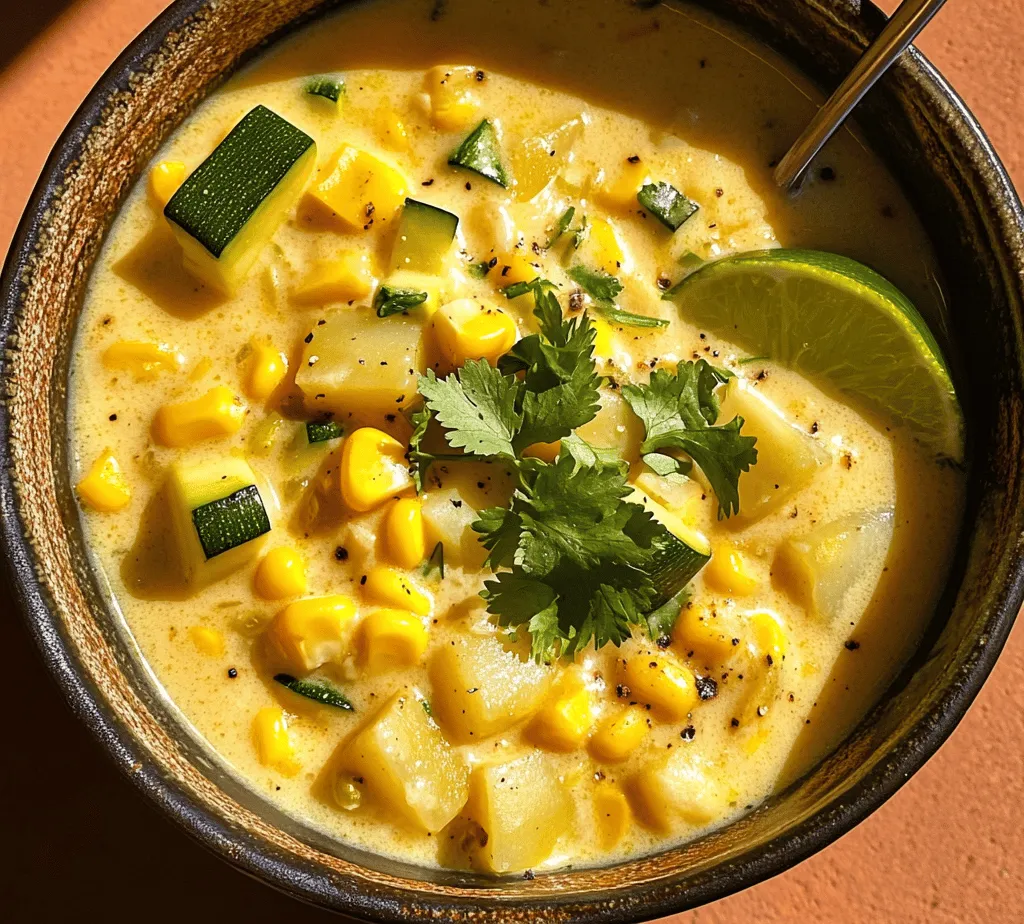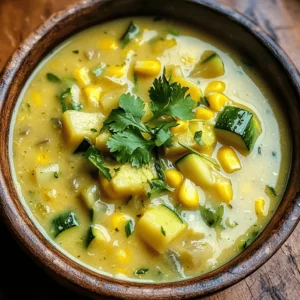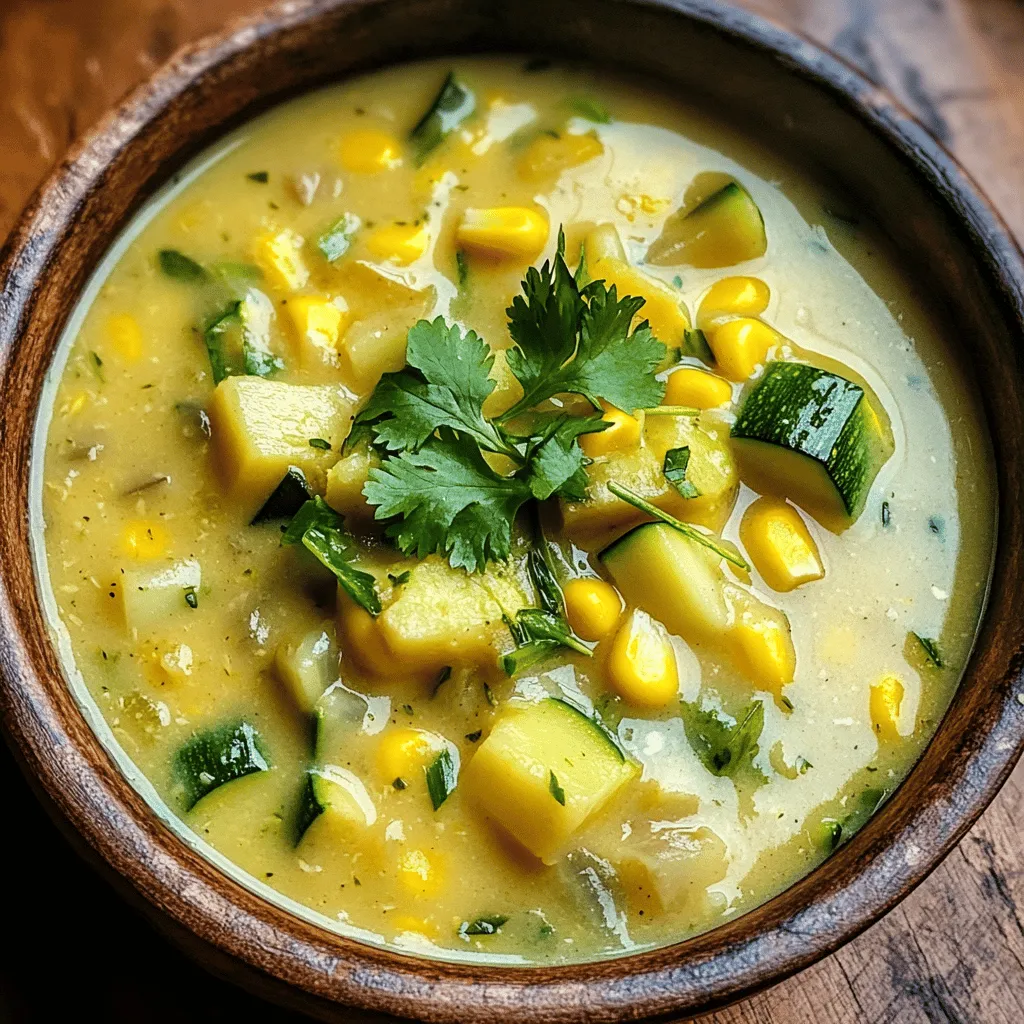Introduction
As the summer sun warms the days, it brings with it a bounty of fresh produce that bursts with flavor and nutrition. This is the season when gardens yield an abundance of vegetables, and local farmers’ markets overflow with vibrant colors and enticing aromas. One dish that perfectly embodies the essence of summer is the Sunny Delight: Summer Corn and Zucchini Chowder. This refreshing and nutritious chowder not only highlights the best of the season’s ingredients but also provides a comforting meal suitable for warm weather dining.
Incorporating fresh corn, zucchini, and a medley of other wholesome ingredients, this chowder is a delightful way to celebrate summer flavors. The sweetness of the corn pairs beautifully with the tender zucchini, creating a creamy concoction that is both satisfying and invigorating. Using seasonal ingredients not only enhances the taste of your dishes but also ensures that you are consuming the highest quality produce available. Freshness contributes to better flavor, improved nutrition, and a more sustainable approach to cooking, especially during the summer months.
Understanding the Ingredients
To create a truly stellar chowder, it’s essential to understand the core ingredients that come together to form this dish. Each component plays a significant role in both flavor enhancement and nutritional value.
Fresh Corn: Nutritional Profile and Flavor
Fresh corn is the star ingredient in this chowder, lending its natural sweetness and crunchy texture. Packed with essential vitamins, corn is rich in dietary fiber, which promotes healthy digestion, and contains antioxidants that can help combat oxidative stress. The bright yellow kernels also provide a source of B vitamins, which are important for energy metabolism. When selecting corn, look for ears with bright green husks and plump, moist kernels. The fresher the corn, the sweeter and more flavorful your chowder will be.
Zucchini: Health Benefits and Culinary Versatility
Zucchini, another key ingredient in this chowder, is a versatile summer squash that adds both bulk and nutrition. Low in calories but high in water content, zucchini is an excellent choice for those looking to maintain a healthy diet. It is a good source of vitamins A and C, both of which are crucial for maintaining healthy skin and immune function. Its mild flavor and soft texture when cooked make it an ideal addition to soups and chowders. Choose small to medium-sized zucchinis for the best flavor and texture, as larger ones can be more watery and seedy.
Potatoes: Nutritional Value and Textures in Chowder
Potatoes add heartiness to this chowder, creating a satisfying and creamy base. They are an excellent source of carbohydrates, providing energy, as well as dietary fiber, vitamin C, and potassium. When using potatoes in chowder, it’s important to choose the right type. Waxy potatoes, such as red or fingerling varieties, hold their shape well when cooked, while starchy potatoes, like Russets, yield a creamier texture. The choice depends on whether you prefer a chunkier or smoother consistency in your chowder.
Onion and Garlic: Flavor Enhancers and Health Properties
Onions and garlic are essential for building the flavor base of any chowder. Sautéing these aromatics releases their natural sweetness and depth, enhancing the overall taste of the dish. Onions provide dietary fiber, antioxidants, and various vitamins, while garlic is renowned for its immune-boosting properties and potential heart health benefits. The combination of onion and garlic creates a fragrant foundation that elevates the chowder.
Vegetable Broth: Importance of Homemade vs. Store-Bought
The choice of broth can significantly affect the final flavor of your chowder. Homemade vegetable broth is often preferred for its freshness and ability to control the ingredients. It allows you to create a rich, flavorful base that complements the other ingredients beautifully. However, if time is of the essence, high-quality store-bought vegetable broth can also serve as a convenient alternative. Look for brands that are low in sodium and free from artificial additives to ensure you’re making a healthy choice.
Heavy Cream vs. Coconut Milk: Dietary Preferences and Substitutions
When it comes to achieving that creamy texture in chowder, you have options. Traditional recipes often call for heavy cream, which adds richness but also significant calories and fat. For those looking for a lighter or dairy-free alternative, coconut milk works wonderfully. It imparts a subtle sweetness and a silky texture, making it an excellent substitute. When using coconut milk, opt for full-fat versions for the best creaminess, or light versions if you prefer a lower-calorie option.
Optional Ingredients: Fresh Herbs and Lime Juice for Added Flavor
To elevate your chowder further, consider adding fresh herbs such as parsley, cilantro, or basil. These herbs not only enhance the flavor profile but also add a burst of color and freshness that complements the summer ingredients. A squeeze of lime juice at the end can brighten the flavors and add a refreshing zing to the chowder, making it even more delightful.
Preparation Steps
Preparation is a crucial step in ensuring that your Sunny Delight Chowder turns out perfectly. Here’s a detailed guide on how to prepare each ingredient for maximum flavor and texture.
How to Properly Husk Corn and Remove Kernels
Husking corn is simple but requires a bit of technique. Start by peeling back the green husks from the top of the ear to the base, removing any silk strands as you go. Once the corn is fully husked, hold the ear vertically on a cutting board and use a sharp knife to slice down the sides, removing the kernels. Be sure to cut just deep enough to get the kernels without cutting into the cob itself. Collect the kernels in a bowl and set them aside for later use in the chowder.
Tips on Dicing Zucchini and Onions for Even Cooking
For even cooking, it’s important to dice your zucchini and onions uniformly. Start by cutting the zucchini into thin rounds, then stack a few rounds and slice them into matchsticks before cutting them into small cubes. This technique ensures that they cook at the same rate and blend seamlessly into the chowder. For onions, begin by slicing off the top and bottom, cutting them in half, and then dicing them into small pieces. The smaller the dice, the quicker they will cook and meld into the chowder.
Techniques for Cubing Potatoes to Achieve the Right Texture in Chowder
When cubing potatoes, aim for uniform cubes that are about ½ inch in size. This size allows them to cook evenly without becoming mushy. Start by peeling the potatoes (if desired) and cutting them into quarters lengthwise. Then, cut each quarter into smaller cubes. Rinse the cubed potatoes under cold water to remove excess starch, which can help prevent them from becoming gummy when cooked.
Importance of Cooking Order: Sautéing Aromatics Before Adding Other Ingredients
The order in which you add ingredients during the cooking process is vital for developing flavors. Begin by heating a drizzle of oil in a large pot over medium heat, then add the diced onions and sauté until they become translucent and fragrant. Follow with minced garlic, cooking briefly until aromatic. This step lays a solid flavor foundation for the chowder. After the aromatics are ready, you can add the cubed potatoes, zucchini, and corn, allowing them to soften before adding the broth and other liquids.
—
This detailed introduction and preparation guide sets the stage for crafting a delicious Summer Corn and Zucchini Chowder. With fresh ingredients and mindful preparation techniques, you’re well on your way to enjoying this seasonal dish that embodies the best of summer. Stay tuned for the next section, where we’ll delve into the cooking process and finalize your Sunny Delight Chowder.

Importance of Sautéing for Flavor Development
Sautéing is a crucial step in elevating the flavor profile of your Sunny Delight: Summer Corn and Zucchini Chowder. By cooking the onions, garlic, and other aromatic vegetables in a bit of oil, you unlock their natural sugars and enhance their sweetness, resulting in a deeper, richer base for your chowder. This technique not only adds layers of flavor but also helps to create a well-balanced dish.
Start by heating your oil over medium heat until it shimmers, then add your onions and garlic. Sauté them for about 5 minutes, or until the onions become translucent and fragrant. This initial step is essential—don’t rush it! The longer you allow the onions to cook, the sweeter and more flavorful they become, setting a solid foundation for the rest of your ingredients.
Key Cooking Times for Achieving Tender Vegetables
Once you’ve sautéed your aromatics, it’s time to add the rest of your vegetables. Timing is key to achieving that perfect tender-crisp texture. For the corn and zucchini, aim for about 10-12 minutes of cooking after adding them to the pot. The corn should be bright and sweet, while the zucchini should retain a slight bite. If you’re including any additional vegetables, such as bell peppers or carrots, consider their cooking times. Carrots, for example, may need a few extra minutes to soften up properly.
Adjusting Consistency: How to Modify Thickness to Suit Personal Preferences
One of the great things about chowder is its adaptability. When it comes to consistency, you can easily adjust the thickness to suit your personal preference. If you prefer a thicker chowder, allow it to simmer uncovered for an additional 5-10 minutes to reduce the liquid. Alternatively, if you like a thinner consistency, simply add more vegetable broth or water until you reach your desired texture.
Using an immersion blender is another excellent way to achieve a creamy texture without the need for heavy cream. Blend a portion of the chowder for about 10 seconds to incorporate some of the corn and zucchini while leaving plenty of chunky pieces intact. This method provides both creaminess and substance, making it a great option for those looking to keep their chowder lighter.
Flavor Profile and Variations
The flavor profile of Sunny Delight Chowder is a delightful medley of sweet corn, fresh zucchini, and fragrant herbs, highlighted by the smokiness of paprika and the earthiness of thyme. Smoked paprika adds a unique depth, complementing the sweetness of the corn while imparting a subtle warmth. Thyme introduces a fresh, herbal note that rounds out the dish beautifully.
If you’re looking to switch things up, consider incorporating some variations and substitutions. For a robust twist, try adding protein-rich ingredients such as canned beans, shredded chicken, or even diced tofu. These additions not only make the chowder heartier but also boost its nutritional value.
Seasonal produce can also play a vital role in enhancing your chowder. Feel free to include vegetables like diced tomatoes, spinach, or green beans—these ingredients can complement the existing flavors while also utilizing what’s fresh from your local farmer’s market.
For those seeking dairy-free options, coconut milk makes an excellent substitute for heavy cream, providing a creamy texture while adding a hint of sweetness. Additionally, you can enhance the flavor by incorporating a splash of lemon juice or a sprinkle of nutritional yeast for a cheesy taste without the dairy.
Serving Suggestions
When it comes to serving your Sunny Delight Chowder, consider pairing it with complementary side dishes that enhance the overall meal experience. A fresh garden salad tossed with a light vinaigrette can provide a refreshing contrast to the rich flavors of the chowder. Additionally, crusty artisan bread or homemade garlic bread makes for a perfect accompaniment, perfect for soaking up every last drop of the chowder.
Presentation is key when serving chowder. Consider garnishing each bowl with a sprinkle of fresh herbs, like chopped parsley or cilantro, and a dash of smoked paprika for a colorful finish. A drizzle of olive oil or a dollop of sour cream can also add a touch of elegance and extra flavor.
Nutritional Analysis
One of the significant benefits of Sunny Delight Chowder is its nutritional content, making it a wholesome summer dish. On average, a serving provides approximately 200-250 calories, depending on the specific ingredients used. Each bowl is packed with essential vitamins and minerals from the fresh corn and zucchini, including Vitamin A and C, potassium, and dietary fiber.
The inclusion of vegetables not only makes this chowder low in calories but also high in nutrients, contributing to a balanced diet. The fiber content aids in digestion, while the rich array of vitamins supports immune health—making this chowder a great choice for warm summer days when you want something light yet nourishing.
Conclusion
In summary, Sunny Delight: Summer Corn and Zucchini Chowder is a refreshing and versatile dish that celebrates the vibrant flavors of summer produce. Its creamy texture, balanced flavor profile, and adaptable nature make it a perfect choice for casual family dinners or entertaining guests. We encourage you to experiment with various ingredients and personalize it to your liking, ensuring that each bowl reflects the seasonal bounty available in your area.
Cooking during the summer months should be a joyful experience, shared with family and friends around the table. So gather those fresh vegetables, fire up your stove, and enjoy the process of creating this delightful chowder. Whether you stick to the classic recipe or put your spin on it, the enjoyment of crafting and sharing a delicious meal will undoubtedly bring a smile to your face and warmth to your heart.



